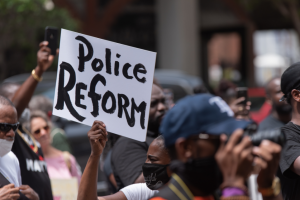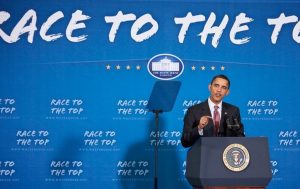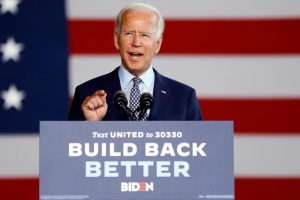Race To The Top as a Blueprint for National Police Reform
May 9th, 2022
Isaac Velez
Race to the Top as a Blueprint for National Police Reform
I. Executive Summary
Police misconduct is a perennial issue in the United States that disproportionately affects minority communities. The similarities between police reform and education reform policy create an opportunity to replicate a Race To The Top program to reform and reverse trends that policing reinforces. The White House and the Department of Justice should request $6 billion from Congress for legislation to recreate Race To The Top (RTTT) with the goal of reforming police departments nationally. While there are differences between education and policing that could reduce the impact that a repurposed Race To The Top program would have on police departments, the program’s design is proven to quickly and successfully change state and local policies and should be attempted for other national reform efforts.
II. Problem Statement
The result of policing in America is that many minority communities disproportionately face brutality, discrimination, and other forms of misconduct as compared to their white peers. Black Americans are three times more likely to be killed and Latinos are twice as likely to be killed by police than White Americans. Furthermore, a study from researchers at Rutgers University, Michigan University, and Washington University found that death by police is a leading cause of death for young Black men in America. Statistics like these and the frequency of gruesome murders by police, such as the cases of George Floyd, Breonna Taylor, Eric Garner, Michael Brown, Philando Castille, and many more, suggest that police reform is needed to reverse these trends.

However, national police reform is difficult to accomplish because it is primarily a state and local issue. While most police departments receive funding from the Department of Justice (DOJ), policing is administered by local and state governments. Moreover, police unions have a powerful presence at all levels of government. The Fraternal Order of Police is the country’s largest union with more than 2,000 chapters and nearly 350,000 members. Police unions have used tools like collective bargaining agreements and lobbying for state laws, among others, to protect police officers from facing disciplinary action for misconduct. While some police reform advocates suggest that defunding the police and finding alternatives to policing is a feasible solution, in his 2022 State of the Union speech, President Biden proclaimed “We should all agree, the answer is not to defund the police. It’s to fund the police. Fund them. Fund them. Fund them with resources and training. Resources and training they need to protect their communities.” This statement has reinforced national sentiments, among all demographics, that policing plays an irreplaceable role in American society. However, the essential function of policing in America does not give a pass to the current mediocrity, malpractice, and racist actions we see within police departments across the country. It suggests that we must hold the police to a higher standard, and work within the system to incentivize reforms and make policing more accessible, accountable, and community oriented for everyone, not just the wealthy suburbs.
To better understand how the federal government can play a role in reforming policing, the Background section below will provide insights into how applications from Race to The Top, a competitive grant program that successfully reformed schools nationally administered by the U.S. Department of Education (ED), can be repurposed for national police reform.
III. Background
The RTTT program was born out of a provision in the American Recovery and Reinvestment Act of 2009 and implemented by the Obama administration. The program was successful in its goal of incentivizing national education reform through a national competition for state applicants. The Obama administration asked states and local education agencies to suggest ways in which they would use the federal funds by grouping them into six categories:
- Great Teachers and Leaders, which offered the largest opportunity to receive points. This category was meant to improve school effectiveness by focusing on teacher and principal performance, rather than student performance.
- State Success Factors, which focused on states articulating their reform agenda, building capacity to implement and sustain this agenda, and demonstrating progress in raising achievement through performance metrics.
- Standards and Assessments which included adopting common standards such as Common Core, and supporting school transitions to common and high quality assessments.
- General Selection Criteria which involved supporting charter and other innovative schools.
- Turning Around the Lowest-Achieving Schools which included more extreme measures such as firing underperforming teachers and principles, or turning the school over to a charter.
- Data Systems to Support Instruction. This category included implementing a statewide longitudinal data system and using data to improve instruction in schools.
In addition to these six categories, there were 15 all-or-nothing points that states could receive based on six priorities such as prioritizing STEM education, and attempting innovations for improving early learning outcomes. States that received RTTT funding adopted 88 percent of RTTT reforms, while applicants who did not receive funding implemented 68 percent, and states that did not apply for funding implemented 56 percent of reforms. Further, there are a number of similarities between education reform and police reform that lead RTTT, as a successful incentive tool, to be a model for facilitating police reform.
IV. Similarities between Education and Police Reform
First, education policy and policing are both issues that rely on federalism. In both instances, the federal government provides financial resources to state and local governmental agencies which then determine the policies they consider appropriate for their individual schools and police precincts. While federalism poses challenges because of the various actors involved in funding, oversight and management, it created an opportunity for ED to tie education reform to $4.35 million. To win an award, states would compete for a grant based on their proposed efforts to effectively apply reforms.

Second, in education and policing there are strong lobbies including unions and advocacy organizations that resist change in order to protect their members. For instance, the National Education Association and the American Federation of Teachers have a significant impact in influencing policy to protect teachers. Likewise, the Fraternal Order of Police and the International Association of Chiefs of Police, as mentioned earlier, have also played a significant role lobbying in favor of police officers at all levels of government. However, RTTT was successful in reducing the role that union and advocacy groups had in derailing the policy implementation process for education reform because the awards were too enticing for state governments to pass on.
Third, there are a multitude of indicators suggesting the need for national police reform at this moment. The Black Lives Matter protests in the summer of 2020 following his murder demonstrate a large appetite for reform to address police brutality and misconduct. Aside from the dismal rates of police violence towards racial and ethnic minorities previously mentioned, rising rates of violent crime, the national police shortage, and the economic impacts of the COVID-19 recession on police departments create an opportunity for reform through a competitive program like RTTT. Similarly, preceding RTTT’s passage and implementation, there was a desire to reform schools in the United States as a result of lagging international competitiveness in testing, achievement gaps among minority groups and white peers, and the economic impact of the Great Recession on schools. The implementation of this incentivized program for education reform promoted teacher accountability, an investment in data infrastructure, and common standards for local school districts; furthermore, police reform would benefit from a similar grant program to create police accountability through independent police investigators in departments, investments in data, and standardization in training to address the institutional failures that expose civilians to harm at the hands of the police.
Lastly, RTTT was successful in part because ED allowed a coalition of trusted experts to help create the standards and reform principles driven by the RTTT competition. Various expert organizations, unions, and advocacy groups trusted in bipartisan settings, such as the Gates Foundation, the National Governors Association, the Council of Chief State School Officers, and the U.S. Chamber of Commerce played a role in dictating common education standards and determining reforms to address the gaps that were leading to disparate education outcomes. Comparably, trusted experts in the field of criminal justice reforms could build a bipartisan coalition to guide the goals for police reform that would be amenable to the relevant stakeholders. This includes organizations such as the Brennan Center for Justice, the Brookings Institution, the CATO Institute, and philanthropic organizations with aspirations of leading a police reform effort.
V. Recommendation
There are many similarities between the conditions that led to education reform in the RTTT era and the call for police reform today. Therefore, I recommend that the White House work in conjunction with the DOJ to retrofit the RTTT program for police reform. Within this recommendation, there are steps that the White House and the DOJ can take to promote RTTT 2.0 focused on reforming police departments.

Initially, the Biden administration should advocate for a provision in the Build Back Better Act, the social spending bill currently being negotiated in Congress for an incentive grant geared towards state applicants to fund police departments. This could be set at $6 billion, which is comparable to the $4.35 billion for RTTT in 2008-2009 after accounting for inflation. Furthermore, the White House and the DOJ should determine their police reform priorities in conjunction with expert organizations in the criminal justice field to ensure the effectiveness of proposed police reform goals and standards. For instance the Biden administration could incentivize evidence-based procedural reforms such as banning chokeholds, requiring de-escalation, banning shooting at moving vehicles, and establishing independent civilian review boards of police misconduct.
This process would also incorporate police union concerns to reduce the risk of political derailment, and philanthropic organizations to promote these ideas among its networks. Lastly, the new iteration of RTTT for policing should consider the drawbacks that reduced the effectiveness of an equitable RTTT implementation by ED. This could include increased opportunities for technical assistance for state applicants and focusing enhanced assistance efforts for specific groups of police departments such as urban, suburban, and rural areas as they all face unique challenges in enforcing the law.
VI. Conclusion
The circumstances linking education and police reform are quite similar, however they are not identical. Police unions have arguably far more power than teacher unions do and may be successful in thwarting reform efforts to protect its members as was recently done with Senators Booker (D-NJ) and Scott (R-SC) in their attempt at reforming police. A RTTT 2.0 could face an insurmountable amount of risk due to dissimilar aspects between education and police reform, the polarization present in the issue of policing, and American politics being more polarized now than in the 2008 era. However, the aforementioned success that RTTT had in quickly and effectively changing state and local education policies through incentives and competition during a period of necessary change and standardization is a proven model that should be attempted for other reform efforts that the United States grapples with such as police reform.
Bibliography
Bazelon, Emily. “Police Reform Is Necessary. but How Do We Do It?” The New York Times. The New York Times, June 13, 2020. https://www.nytimes.com/interactive/2020/06/13/magazine/police-reform.html.
Edwards, Frank, Hedwig Lee, and Michael Esposito. Risk of being killed by police use of force in the United States by age, race–ethnicity, and sex. Proceedings of the National Academy of Sciences, August 5, 2019. https://www.pnas.org/doi/10.1073/pnas.1821204116.
Howell, William G. “Results of President Obama’s Race to the Top.” Results of President Obama’s Race to the Top. Education Next, March 11, 2022. https://www.educationnext.org/results-president-obama-race-to-the-top-reform/.
Merkl, Taryn A. “Protecting against Police Brutality and Official Misconduct.” Brennan Center for Justice. Brennan Center, March 25, 2022. https://www.brennancenter.org/our-work/research-reports/protecting-against-police-brutality-and-official-misconduct.
Parker, Kim, and Kiley Hurst. “Growing Share of Americans Say They Want More Spending on Police in Their Area.” Pew Research Center. Pew Research Center, October 26, 2021. https://www.pewresearch.org/fact-tank/2021/10/26/growing-share-of-americans-say-they-want-more-spending-on-police-in-their-area/.